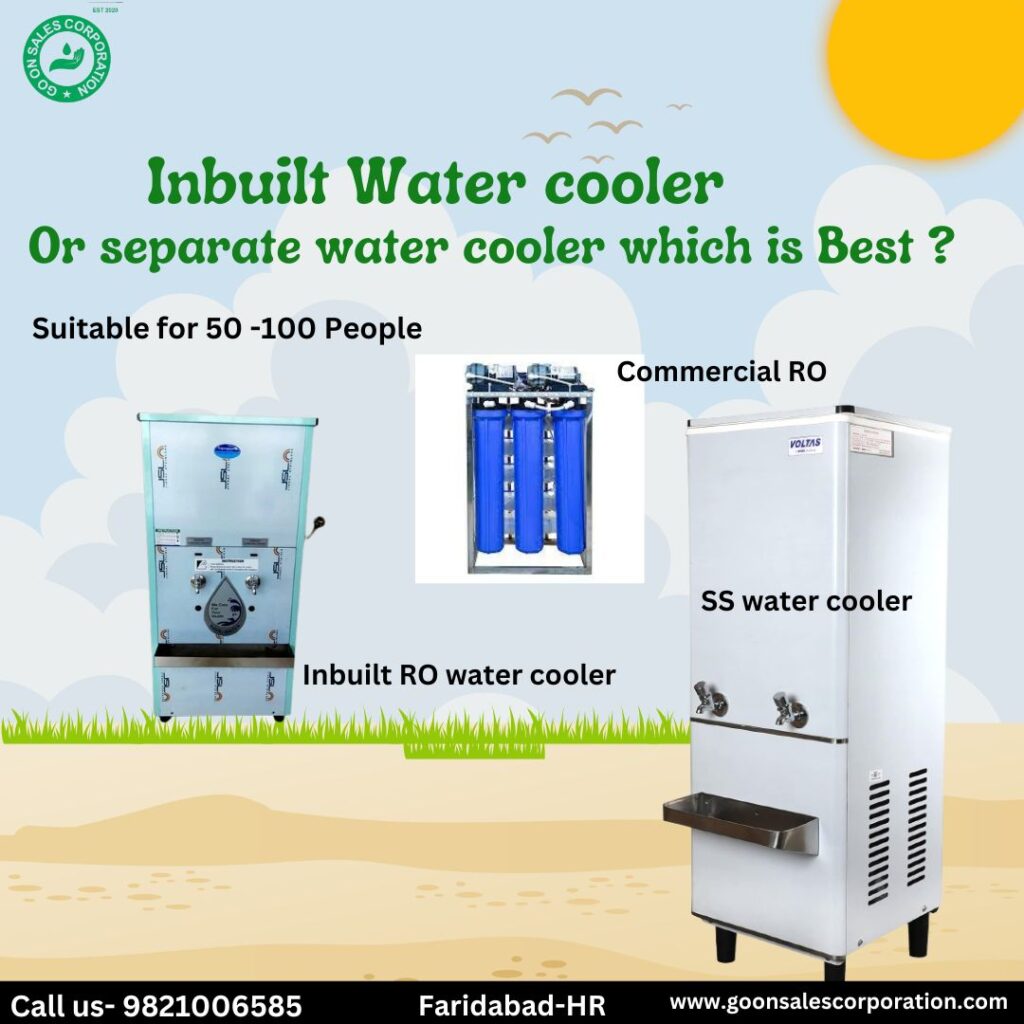When selecting a water purification and cooling solution for offices, schools, industries, or public places, two main options are available: an inbuilt RO water cooler or a separate RO system with a water cooler. Understanding their differences in cost, specifications, and benefits can help you make the right choice.
1. Inbuilt RO Water Cooler
An inbuilt RO water cooler is a single unit that combines a Reverse Osmosis (RO) system with a water cooler. It is a compact, space-saving solution designed for places with limited installation space.
Specifications:
- Filtration Capacity: Available in 40 LPH, 80 LPH, 120 LPH, or more
- Cooling Capacity: 20L, 40L, 80L, 120L, 150L storage options
- Stages of Purification: Typically 5-7 stages, including Sediment Filter, Carbon Filter, RO Membrane, UV Purification, and Post-Carbon Filter
- Body Material: Stainless steel (SS-304), rust-resistant and durable
- Power Consumption: Moderate, as both cooling and purification functions are integrated
- Installation: Easy plug-and-play design, requiring minimal plumbing
Advantages of Inbuilt RO Water Cooler:
✅ Space-Saving: Combines two units into one, ideal for compact areas ✅ Convenience: Directly dispenses RO-purified, chilled water ✅ Low Maintenance: Single unit means fewer maintenance requirements ✅ Aesthetic Appeal: Sleek and professional appearance, suitable for offices and institutions ✅ Energy Efficiency: Optimized for lower power consumption than two separate units
Disadvantages of Inbuilt RO Water Cooler:
❌ Higher Initial Cost: More expensive upfront compared to standalone RO systems ❌ Limited Degradability: The RO system capacity cannot be upgraded separately ❌ Dependency on a Single System: If one component fails, the entire system might stop functioning
2. Separate RO System with Water Cooler
A separate RO system and water cooler means, having two independent units—one for water purification and another for cooling. This option provides more flexibility and is ideal for larger-scale operations.
Specifications:
- RO System Capacity: Ranges from 25 LPH to 2000 LPH, depending on requirements
- Cooling Capacity: Available in 20L, 40L, 80L, 120L, and 150L+ storage sizes
- Stages of Purification: Generally includes 6-8 purification stages with additional pre-filters
- Body Material: Stainless steel (SS-304) for the water cooler; RO systems are available in FRP, SS, or MS material
- Power Consumption: Higher due to two separate units
- Installation: Requires more space and setup effort, including plumbing connections between the RO system and cooler
Advantages of Separate RO System with Water Cooler:
✅ Customizable & Scalable: RO system capacity can be upgraded independently ✅ Better Performance for Large-Scale Use: Ideal for factories, hospitals, and public places with high water demand ✅ Longer Lifespan: Independent units reduce the risk of total system failure ✅ Cost-Effective for High Usage: More economical over time due to separate maintenance options ✅ Redundancy: If the RO system or water cooler fails, the other can still function independently
Disadvantages of Separate RO System with Water Cooler:
❌ Requires More Space: Needs additional installation area for both units ❌ Higher Maintenance Costs: Two separate units mean servicing costs might be higher ❌ More Initial Setup Work: Requires proper plumbing and electrical connections between the RO unit and cooler
3. Cost Comparison
| Feature | Inbuilt RO Water Cooler | Separate RO & Water Cooler |
|---|---|---|
| Initial Cost | Higher (₹50,000 – ₹1,50,000) | Moderate to High (₹40,000 – ₹2,00,000) |
| Maintenance Cost | Lower (Single unit servicing) | Higher (Two units to maintain) |
| Lifespan | Moderate | Longer |
| Flexibility | Fixed system, less degradability | Flexible and upgradable |
| Space Requirement | Less space | Requires more space |
| Suitability | Offices, Schools, Small Industries | Factories, Large Offices, Public Places |
4. Which One Should You Choose?
Choosing between an inbuilt RO water cooler and a separate RO system with a water cooler depends on specific needs, budget, and available space.
Best for Small-Scale Use:
If you need a compact, easy-to-maintain, and energy-efficient solution for a school, office, or small business, an inbuilt RO water cooler is the best choice. It offers hassle-free installation, looks modern, and requires less maintenance.
Best for Large-Scale Use:
For factories, hospitals, large offices, and industrial setups with high water demand, a separate RO system with a water cooler is recommended. This option allows flexibility in choosing the right RO capacity, independent maintenance, and better long-term cost efficiency.
Conclusion
Both inbuilt RO water coolers and separate RO systems with water coolers have their advantages and limitations. The decision depends on space, budget, water demand, and maintenance considerations.
Go On Sales Corporation provides a wide range of both inbuilt RO water coolers and separate RO systems with water coolers, ensuring you get the right solution for your needs. Contact us for expert advice and customized solutions!


